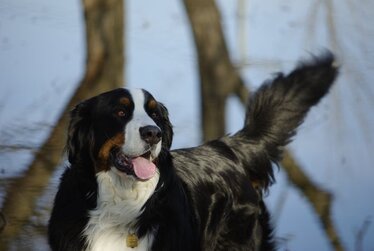Canadian Kennel Club Breed Standard

GENERAL APPEARANCE: Large, sturdy, well-balanced working dog of substantial bone. Square in appearance from withers to ground and withers to tail set. Heavy-coated with distinctive characteristic markings. In comparison with the opposite sex, dogs appear masculine, bitches feminine without loss of type.
TEMPERAMENT: The Bernese temperament is one of the breed's strongest assets. Consistent, dependable, with a strong desire to please. Self-confident, alert, good natured. Attached and loyal to human family; may be aloof or suspicious with strangers, but never sharp or shy. A dog must stand for examination when required to do so by its handler.
SIZE: Dogs 24.4 - 27.6 inches (62-70 cm), best size 26 - 26.8 inches (66-68 cm); bitches 22.8 - 26 inches (58-66 cm) best size 23.6 - 24.8 inches (60-63 cm). Height measured at withers. The stocky, well-balanced appearance must be maintained.
COAT AND COLOUR: The adult coat is thick, moderately long, possibly with a slight wave but never curly. It has a bright natural sheen. In texture it is soft rather than harsh, but is weather resistant, easily kept and resists matting. There is a soft, seasonal undercoat. Compulsory markings: Jet-black ground colour. Rich russet markings (dark reddish brown is most favoured) appear on the cheeks, in a spot over each eye, in a patch above each foreleg, and on all four legs between the black of the upper leg and the white of the feet. Clean white markings as follows: On chest extending uninterrupted to under chin; also a slight- to middle-sized blaze extending into a muzzle band which is not so wide as to obliterate the russet on the cheek (and which preferably does not extend past the corners of the mouth). Preferable markings: White feet with white reaching at the highest the pasterns and a white tip of tail. Marking should be symmetrical. Too little white is preferable to too much.
HEAD: Skull - Flat and broad with a slight furrow; defined, but not exaggerated stop. Muzzle - strong and straight; roughly square proportions, tapering only very slightly. Muzzle is slightly shorter than length of skull. Lips are fairly clean and tight; black in colour. Teeth - jaw is strong with good teeth meeting in a scissors bite. Dentition should be complete. Nostrils - well open and black in colour. Eyes - dark brown in colour, almond shaped, and well set apart; tight eyelids. Expression is intelligent, animated and gentle. Ears - middle-sized triangular in shape with rounded tip. Set above eye level high on side of head; hanging close to the head in repose, brought forward at the base when alert.
NECK: Strong, muscular, of medium length, well set on. Dew-laps are very slightly developed.
FOREQUARTERS: Shoulders are well muscled, flat lying and well laid back. Forelegs are straight with substantial bone; parallel stance. Elbows are well under shoulders. Pasterns are slightly sloping, but not weak. Feet are proportionate in size, round and compact. Dew claws are preferably removed.
BODY: Approximately square from withers to ground and withers to tail set. The body is sturdy. The chest is broad, with good depth of brisket reaching at least to the elbows; ribs are well sprung. The back is firm and level. Loins are strong and muscular. The croup is broad, well muscled.
HINDQUARTERS: The hindquarters are powerful, with broad, well-muscled thighs and substantial bone. Stifles are well angulated. Hocks are well let down, turning neither in nor out. Pasterns are wide and straight, standing parallel. Feet are proportionate in size, round and compact. Dew claws must be removed in the first few days of life.
TAIL: Bushy, hanging straight, with bone reaching to the hock joint or slightly below. Carried low in repose, higher when the dog is in motion or alert. An upward arc is permissible, but the tail should never curl over itself or be carried over the back.
GAIT: The natural traveling gait of the breed is a slow trot, but it is capable of speed and agility. Good reach in front. Strong drive from the rear, flexing well at the stifles. The level backline is maintained; there is no wasted action. Front and rear feet of each side travel in lines parallel to direction of motion, converging towards a centre line at increased speeds.
FAULTS: A fault is any deviation from the standard, to be weighed in accordance with the degree of deviation. In addition and in particular: Major faults: ectropion or entropion; undershot or overshot mouth; tail rolled over back. Minor faults (subject to degree of fault): deficiency of type, particularly lack of substance; overly long or thin body; light or round eyes; level bite; incomplete dentition; too narrow or too snipey muzzle; too massive or too light head; too light russet markings or impure colour; grey colouring in black coat; nonsymmetrical markings, especially facial; white neck patch; white anal patch; curly coat in adult dog; splayed feet; kink in tail.
DISQUALIFICATIONS: Cryptorchid or monorchid males; split nose; absent markings as described in compulsory markings; white neck ring; blue eye; ground colour other than black.
